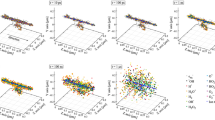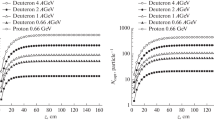Abstract
The last few years have seen a rise in the number of particle accelerators built in Korea. However, there has been relatively little focus on accelerator-based study of secondary particles (such as rare-isotope beams) in the context of nuclear physics, biophysics, and dark matter research. In this context, we compare our simulation results with experimental data on various heavy-ion beams. We determine the optimized simulation toolkit and its parameters for these experiments. Since the Geant4 is more accurate than any other simulation packages, we use the Geant4 toolkit in the study. We also provide the relevant references for various issues arising in our study. We simulate the interaction of particles with target material and study the characteristics of heavy-ion beams. With regard to study design, first, we examine the validity of the Geant4 model. Next, we examine the various physics models built in the Geant4 to determine the most optimized model that describes the expected physical phenomena. Finally, we execute the Geant4 simulations to determine the characteristics of secondary heavy-ion beams. We plan to use these results for rare isotope accelerator complex for on-line experiment (RAON), which is an upcoming facility for heavy-ion collision experiments in Korea.
Similar content being viewed by others
Explore related subjects
Discover the latest articles, news and stories from top researchers in related subjects.Avoid common mistakes on your manuscript.
1 Introduction
With increase in the global demand for accelerators, we need the cost-effective simulation toolkit. To create a given environment for experiments, we need to determine the corresponding optimized simulation toolkit and its relevant parameters. Recently, isotope separation on-line (ISOL) systems, which comprise a fixed target experiment on which proton beams are made incident, have been used to generate rare-isotope (RI) beams. The ISOL method has been effectively used to generate several types of RI beams [1]. Such approaches can aid in the exploration of the structure of exotic nuclei and the further development of nuclear astrophysics. This method has enabled researchers to make unprecedented discoveries in the abovementioned research areas [2].
As a preceding step for experiments with heavy-ion accelerators, in this study, we test Geant4’s physical validity with a simple setup comprising protons colliding with a fixed target. The goal is to select a model that best describes the expected phenomena in the accelerator experiments. Next, we consider controlling secondary particles (i.e., the RI beams) originating from specific targets and beam-energy simulations. We simulate the simplified beam-target geometry to determine what kind of secondary beams are created and how they can be controlled in simulation conditions. Our results provide information that is difficult to obtain experimentally. We plan to apply this result to the chosen technique for the production of precise low-energy beams, such as those required in rare isotope accelerator complex for on-line experiment (RAON) [3].
2 Method
2.1 Simulation tools
In the study, we use the Geant4 toolkit as Monte Carlo simulation tools and compare our results with those of corresponding experiments [4, 5]. The Geant4 simulates the interaction between particles and matters. It is considered to be more accurate than any other similar simulation package [6]. However, Geant4 consumes considerably more CPU time than others; hence, supercomputers are normally used to run Geant4 simulations. Geant4 is written in C + + , which allows microscopic simulations of the propagation of particle interaction with materials [7,8,9]. This package is widely used in areas such as high-energy physics experiments, neutron beam shielding, and medical physics. The validation and detailed description of the Geant4 can be found at the Geant4 website [10].
2.2 Simulation setup
In this work, we consider the experiment in references [11, 12]. The corresponding geometry of the beam and detector is shown in Fig. 1. The source is a 1 GeV/A 238U beam and the target is ionized hydrogen gas. The detailed simulation conditions including beam particle, energy, target materials and thickness are shown in Table 1.
In our simulations, we generated 1 million events and recorded the consumed CPU time for each physics model. In the study, we used Geant4 version 11.0.2 on the Nurion supercomputer at KISTI. Figure 2 shows the relevant physics list suggested via Geant4 collaborations for various beam energies [7,8,9].
3 Results
Simulations were performed with the use of Geant4 version 11.0.2. Table 1 lists the detailed simulation conditions [13, 14].
3.1 Validation of Geant4 simulation toolkit
First, we examined the experiments and corresponding simulations to find the best physics list. Next, we confirmed the best physics list by measuring the CPU times while running 1 million events. Table 2 shows the simulation setup for validation of Geant4.
We considered 13 physics list models: FTFP_BERT, FTFP_BERT_HP, QGSP_FTFP_BERT, FTFQGSP_BERT, FTF_BIC, QGSP_BERT, QGSP_BERT_HP, QGSP_BIC, FTFP_INCLXX, FTFP_INCLXX_HP, QGSP_INCLXX, QGSP_INCLXX_HP, and Shielding. Table 3 list these physics lists along with the corresponding reference lists. For each physics list, one million events are generated on Geant4.
Figure 3 shows the number of generated secondary particles which successfully get out of the target material in the entire solid angle for the various physics models considered. More secondary particles are generated on physics lists including ‘INCLXX’.
Figure 4 shows the amount of the secondary fragments Z. Figure 5 shows the amount of the secondary atom A. The distribution is separated with three groups; “INCL” group, “Shielding”, and the others. Physics lists using “INCL” takes more amounts of secondary particles than other lists because they provide the inelastic process of protons, neutrons, and charged pions. Therefore, they are expected to be appropriate for the experiments considered.
Figures 6, 7, and 8 show the cross-sections of the secondary Cesium (Cs), Rubidium (Rb), and Francium (Fr) ions, respectively. We compared models among the physics lists as well as between simulations and experiments. Here, we remark “Shielding” yields the less secondary particles than observed in experiments. Therefore, this model is not considered. A temperature is only taken into account for neutrons when using the “HP” physics list; it is ignored in all other cases. The results show that there is no significant difference between the various “HP” models. Further, there is no remarkable difference between FTF and QGS. There is also no remarkable difference between BERT and BIC.
Cross-section of secondary particles of Cesium (simulations vs. experiment [13])
Cross-section of secondary particles of Rubidium (simulations vs. experiment [13])
Cross-section of secondary particles of Francium (simulations vs. experiment [14])
After considering the various physics models, we recommend “FTFP_INCL + + ,” while “FTFP_BERT” is the default physics list setting in Geant4. Therefore, we included this model for further analysis.
Figure 9 shows the consumed CPU time for each physics model. The CPU time taken for “Shielding” is 2.5 times than other physics lists. The consumed CPU time confirms that using any physics lists except “Shielding” takes similar CPU times.
3.2 Simulations with proton beam incident on uranium target
With the optimized physics model of “FTFP_INCLXX,” we next examined the secondary particles from the perspectives of beam energy and target thickness. Table 4 lists the specifications for these simulations. Here, we remark that it is necessary to examine the distribution of the atomic mass and atomic number. Thus, we considered the isotopes of Helium (He), Tin (Sn), Cs and Fr, which are the most “useful” atoms in RAON experiments [2, 3]. Subsequently, we obtained the momentum distributions and angle dependency for the given target for the various secondary particles.
In most cases, the total number of ions increases as the target thickness increases. Figures 10 and 11 show the number of secondary particles generated depending on the beam energies and target thickness, respectively. It shows that target thickness thicker than 6 mm produces less secondary particles per thickness of target, because some produced secondary particles cannot get out of the target material. Further, Figs. 12 and 13 show the atomic number distributions and atomic mass distributions, respectively, for various target thickness with 100 MeV/A of beam energy. Figures 14 and 15 show the atomic number distributions and atomic mass distributions, respectively, for various beam energy with 6 mm of target thickness.
Figure 16 shows distributions of the isotope mass of the various secondary particles considered (He, Sn, Cs, Fr) for various beam energies with 6 mm of thickness of target. Figure 17 shows distributions of the isotope mass of the various secondary particles considered (He, Sn, Cs, Fr) for various thickness of target with 100 MeV/A of beam energy.
As mentioned above, we examined the number of secondary tracks depending on the beam energy and target thickness. We also obtained the distributions of the atomic number and atomic mass. Our results indicate that the secondary beam produced has an isotropic distribution that does not depend on the target or beam energy. This information is useful for designing future radioactive experiments.
4 Summary
We determined the optimized simulation toolkit in Geant4 for the optimized simulation environment for a set of rare-isotope beam experiments in our study. Our results indicate that the RI experiments in accelerators being built in Korea can be suitably simulated with the physics list “FTFP_INCLXX”. Using this simulation, we examined the secondary beams of rare isotopes. We studied the secondary beams depending on the thickness of target and beam energies. Our results indicate that the beams are nearly independent of these parameters. In conclusion, we believe that our analysis will aid in studies such as the RAON experiments [2, 3].
References
O. Kofoed-Hansen, K.O. Nielsen, Mat. Fys. Medd. Dan. Vid. Selsk. 26, 1 (1951)
B.H. Kang et al., J. Korean Phys. Soc. 63(7), 1473 (2013)
D. Jeon, I.S. Hong, H.J. Kim, J.W. Kim et al., J. Korean Phys. Soc. 65(7), 1010–1019 (2014)
J. W. Sin, et al., Preprint arXiv:1402.1847v2 [Physics.ins-det] (2014).
J.W. Sin et al., Nucl. Instrum. Meth. B 349, 221 (2015)
K. Cho, J. Astron. Space Sci. 33, 63 (2016)
S. Agostinelli et al., Nucl. Instr. Meth. Phys. Res. A 506, 250 (2003)
J. Allison et al., IEEE Trans. Nucl. Sci. 53, 270 (2006)
J. Allison et al., Nucl. Instrum. Meth. A 835, 186 (2016)
See Geant4 toolkit. http://geant4.cern.ch/
K.A. Olive et al., Particle Data Group. Chin. Phys. C 38, 090001 (2014)
V.N. Panteleev et al., Eur. Phys. J. Spec. Topics 150, 297 (2007)
M. Bernas et al., Nucl. Phys. A 725, 213 (2003)
J. Taieb et al., Nucl. Phys. A 724, 413 (2003)
Acknowledgements
We thank Chanyoung Lee for their assistance with this analysis. This research was supported by the National Research Foundation of Korea (NRF) grant fund by the Korean government (MSIT) (No. 2021R1F1A1064008). This research is also supported by the National Supercomputing Center with supercomputing resources including technical support (KSC-2022-CHA-0003).
Author information
Authors and Affiliations
Corresponding author
Additional information
Publisher's Note
Springer Nature remains neutral with regard to jurisdictional claims in published maps and institutional affiliations.
Rights and permissions
Springer Nature or its licensor (e.g. a society or other partner) holds exclusive rights to this article under a publishing agreement with the author(s) or other rightsholder(s); author self-archiving of the accepted manuscript version of this article is solely governed by the terms of such publishing agreement and applicable law.
About this article
Cite this article
Kim, K., Cho, K. A study on heavy-ion beam simulation using Geant4. J. Korean Phys. Soc. 83, 605–613 (2023). https://doi.org/10.1007/s40042-023-00833-7
Received:
Revised:
Accepted:
Published:
Issue Date:
DOI: https://doi.org/10.1007/s40042-023-00833-7





















